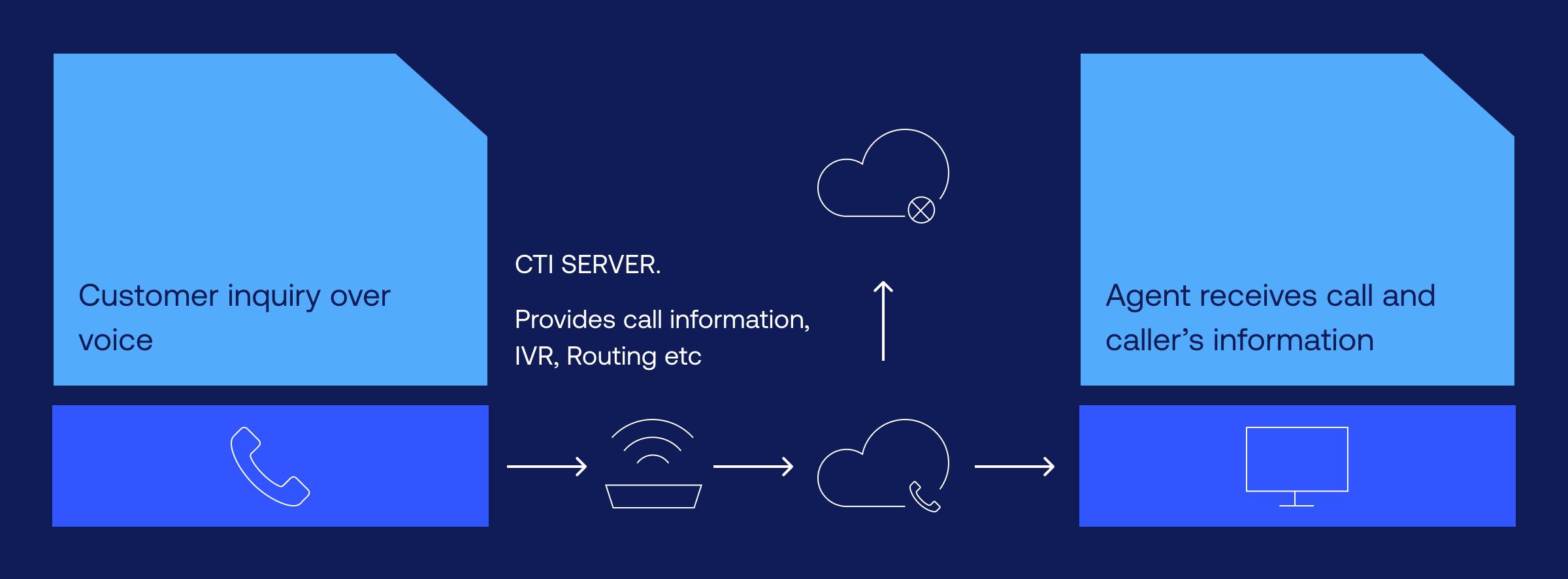
A beginner's guide to Salesforce telephony (CTI) and VoIP integration

You’re likely using Salesforce to manage your communications with leads and customers online—but not all communication occurs through digital methods.
If your sales reps and customer service agents are talking to customers on the phone, they’ll need to manually log the calls in Salesforce, and may not always remember to do so or input correct data. Even for calls that are properly logged, you may not have detailed context of the call or outcome. That can leave gaps in your knowledge of how to manage your customer relationships, leading to poor customer service or to promising deals falling through.
Salesforce’s Computer Telephony Integration (CTI) is the solution to this problem. With this Salesforce VoIP integration, you’ll be able to make calls directly over VoIP from your Salesforce online dashboard, and have them automatically logged.
Here’s a look at how Salesforce telephony integration works.
What are the benefits of Salesforce phone integration?
First, why consider integrating your calling system with Salesforce? Computer-telephony integration is a no-brainer for your business, helping your agents get better context for their calls, lower their handle times, and increase customer satisfaction.
The CTI integration connects seamlessly with your Salesforce dashboard, enabling your agents to instantly access Salesforce data for inbound calls. That means if a prospect or customer is on the line, your agent will be able to see their entire account history, including purchases they’ve made and previous calls that they’ve logged and the issues that have been addressed. Rather than asking the customer to provide information they’ve already shared with the agent’s colleagues, your agent will be able to instantly route the call to the right party, or handle the call and solve the customer’s problem with full knowledge of their previous interactions with your company. That will help ensure that your agent will be able to resolve their issue quickly and efficiently, providing a great customer experience.
Your agents can also improve their own productivity by making outbound calls with just a click within the Salesforce dashboard, eliminating the need to dial manually. Your agents will have full control of call options within the dashboard, including placing the customer on hold, transferring to another agent, and adding people to a conference call. Any notes your agents take during the course of the call will be automatically logged and added to the customer’s Salesforce record.
During the course of each call, managers can use the “whispering” feature to listen in and send notes to their agents through the Salesforce dashboard, providing real-time feedback without interfering on the calls. That’s ideal for employees in training, as well as for providing additional support on important sales calls.
The CTI integration also makes for easier quality control. The telephony feature allows users to record calls, listen to the recordings, and look through the script within the Voice functionality. Users can also create reports based on the tracked call metrics, with the ability to tie different inbound numbers to different marketing campaigns so you can properly attribute your marketing spend.
By integrating CTI for Salesforce, you can move from a siloed and disjointed approach to customer interaction to a cohesive, integrated sales and customer service strategy. Your agents will have the necessary context to provide the best possible service, and will be equipped with the technology to help streamline interactions and improve productivity.
How does CTI Integration with Salesforce work?
So if you want to try CTI Integration with Salesforce, how do you get started?

On a technical level, your development team can use Salesforce’s Open CTI API to integrate CTI with an external VoIP provider. To make a call via Salesforce, the AJAM Connector dials to the Asterix component of the CTI service provider, links the call to the end user, and instructs AJAM to establish the official call and perform other tasks like recording and transferring data. The AJAM Connector is able to fetch Caller ID and related data, and the process is mapped to multiple servers and callers for tracking and calling for both inbound and outbound calls.
What are your Salesforce VoIP Integration options?
There are several options for integrating a telephony system into your Salesforce platform:

A third-party app
You can find a Salesforce telephony integration partner easily on Salesforce’s AppExchange, where you can search through thousands of apps and customer reviews to find the best fit for your needs. Some of the top reviewed options include Vonage Contact Center, Natterbox CTI, Aircall CTI, and RingCentral for Salesforce.
The right integrations can take your Salesforce experience to the next level
Browser extension
You can also search your web browser’s extensions directory for Salesforce telephony integration options. Google Chrome offers several options: the most popular is Click to Call CTI for CRM, offered by Thirdlane.com.
Lightning Dialer
Salesforce’s own “Lightning Dialer” product is a paid add-on offered by Salesforce directly. You’ll pay based on total minutes of time used, and the service includes outbound calling by default with the option to add inbound calling for an additional fee.
Service Cloud Voice
Service Cloud Voice is an AI-enabled integration within Salesforce’s Service Cloud, which you can use with the telephony partner of your choice or out-of-the-box with Amazon Connect for all of your customer support calls. It provides agents with a comprehensive view of all customer service cases across all platforms, including email, chat, app, and phone.
How to integrate Salesforce with your phone service
The Salesforce CTI solution will work only with a VoIP provider, which allows you to use broadband internet to make phone calls over your computer or mobile device, rather than using a mobile or landline phone service. Choose the VoIP service that makes sense for you based on your expected usage and needs—there are several free options available through Salesforce’s AppExchange, but most that would be suitable for business usage are paid on a sliding scale based on usage or features.
Once you’ve chosen the right app or the Salesforce Lightning Dialer, you’ll need to configure it based on your preferred settings, and then customize your Salesforce Service Console. From there, you should be ready to start using the Salesforce CTI integration.
Conclusion
If you’re using Salesforce as a CRM, but haven’t yet explored the benefits of a Salesforce telephony integration, it’s time to make the shift.
You may use a variety of methods to connect with prospects and customers, including email, web chat, SMS, and phone. Moving all of your customer communication channels to one unified platform will help you to share data and context easily throughout your organization; improve agent productivity and efficiency; and ensure that every customer has a high-quality experience, no matter how they connect with you.




